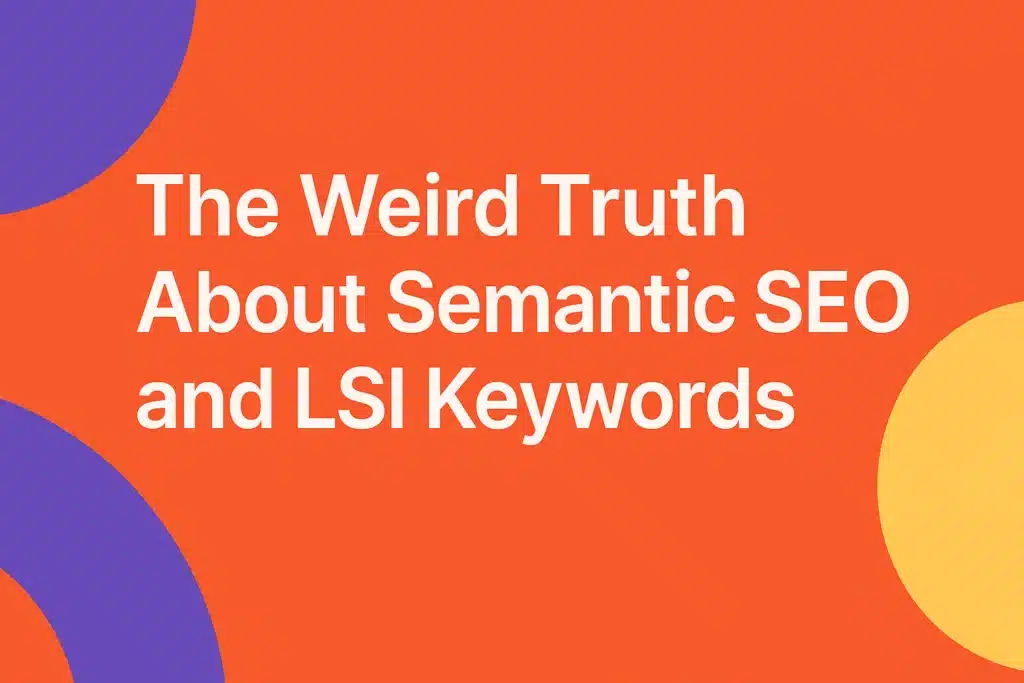Semantic SEO challenges usual keyword strategies by focusing on user intent and related content over simple term matching. It uses an in-depth appreciation of query meaning, context clues, and related concepts. This modern approach changes digital content from routine keyword stuffing into engaging, topic-focused narratives that satisfy search engine algorithms with measurable impact.
Semantic SEO is less about keywords, more about mind-mapping intent
Semantic SEO shifts the focus away from simply stuffing keywords and toward mapping the basic intent behind user queries. It involves creating content that answers broad topic questions while connecting related ideas and entities effectively. Rather than automatically matching terms, it builds a visual map of user needs using natural language patterns that extend reach and clarity. This method enhances organic visibility and ensures that content naturally connects with search queries. By matching ideas with user intent, marketers consistently build trust and achieve improved rankings.
Why search engines aren’t actually reading—they’re guessing
Modern search engines do not read content as humans do; instead, they make educated guesses based on recognized patterns and signals. Their algorithms favor pages that use natural language, internal linking, and a clear topic structure. Many experts claim that these engines prioritize user engagement and familiar platforms instead of deep content analysis. This trend suggests that even when keywords are used precisely, they give way to curated content signals that ultimately guide search rankings effectively. As a result, search engines rely on guesswork rather than literal reading.
The user-language game: How search engines decode our weird phrasing
Today, search engines understand language almost like a game, figuring out casual and quirky user queries with the aid of contextual clues. They use advanced algorithms that copy human understanding instead of merely scanning exact phrases. The surge in voice search forced this change, prompting engines to handle natural speech patterns and unclear wording. So, odd phrasing may still produce relevant results, reflecting a blend of algorithmic guessing and semantic mapping. Ultimately, search engines continuously adjust to the ever-changing patterns of digital communication.
The Strange Life of LSI Keywords in SEO Fiction and Fact
LSI keywords remain a hot topic in SEO despite widespread debunking. Many SEOs still reference these semantic tools even though Google representatives dismiss the concept completely. The debate often centers on technique versus myth, accidentally leading to confusion. Recognizing authentic semantic connections is far more valuable than using outdated keyword models.
What Google said—and didn’t say—about LSI Keywords
Google experts have consistently stated that LSI keywords, as widely understood, do not affect rankings. Official remarks dismiss them as a misguided idea. Although claims about using LSI tools continue, John Mueller has explained that they do not exist. In reality, Google uses an understanding of entity relationships and semantic context. Rather than chasing fake LSI signals, focus on creating content that naturally covers related topics and meets user intent, ensuring genuine relevance and enhanced search performance for robust, long-term ranking success. (Search Engine Roundtable)
Why chasing LSI keywords may feel smart but wastes time
The practice of targeting LSI keywords, though it may seem clever, frequently wastes effort. Experts argue that trying to insert related terms in a fake way often leads to forced language and reduced readability. Instead, concentrate on thorough topic coverage. Detailed content naturally includes semantically connected phrases that meet search intent. Emphasize quality and clarity over merely checking keyword boxes, and avoid falling for outdated myths that add little real value to your SEO strategy. Prioritize strong content over tricks for lasting success.
How correlational thinking became the myth of Google’s brain
Some believe that using related words can boost SEO. However, Google experts have repeatedly denied this myth. Despite claims linking keyword clusters to improved rankings, official statements clarify that no such relationship exists. Related thinking misleads many, supporting outdated practices. Instead, focus on creating genuine, detailed content that naturally connects ideas rather than forcing artificial keyword relationships. Marketers should trust in a solid content strategy and rely on verified SEO techniques, leaving behind myths that inflate the perceived complexity of algorithms. (Search Engine Roundtable)
Structured Data, Voice Tech & Why Machines Want to Talk
The surge in machine-readability has reshaped SEO strategies. Structured data now plays a key role in helping search engines understand page context. Along with emerging voice search trends and evolving AI, digital content requires new methods. This shift moves focus away from mere keywords and drives richer signals for smarter search outcomes.
How structured data SEO makes content ‘machine-fluent’
When you add structured data to your pages, you help search engines quickly understand the meaning of your content. Schema markup acts as a precise label system, explaining what each element represents. This results in improved view through rich snippets and can boost click-through rates. In a digital market where every detail matters, machine-fluent content is noticed, leading to higher user engagement and faster notice across various devices. This strategy ensures that pages communicate effectively with search engine algorithms smoothly. (Insivia)
Voice search optimization is really a war between accents and AI
Voice search is changing how users interact with their devices, creating a battle between diverse accents and artificial intelligence. With many mobile queries phrased as questions, preparing for voice requires natural, conversational language. Businesses must adapt their content to address local differences and varying speech patterns, balancing clear speech with advanced AI understanding to meet the evolving demands of voice-centric search. In this fierce field, companies are forced to refine their voice search strategies for optimal performance. (Medium)
Why topical authority now hinges more on connections than content
Topical authority now depends on the network of content connections rather than sheer volume. Building strong internal links and earning quality backlinks further raise a site’s expertise. It requires a careful focus on linking related topics, encouraging partnerships and mentions among trusted sources. This approach shows to search engines that your content is part of a broader, reliable conversation, enhancing both relevance and ranking signals in today’s fierce digital landscape. Focused connections build trust and boost overall search rankings. (Neil Patel)
Conclusion
Semantic SEO alongside debunked LSI myths show the necessary for modern, intent-driven strategies. By focusing on meaningful content over mere keyword gathering, businesses can align with search engines that put first context and relevance. Structured data and voice search also play critical roles in adapting to tech shifts. By focusing on genuine topic coverage and robust linking, marketers create valuable user experiences that satisfy evolving algorithms. Ultimately, embracing these odd yet effective techniques leads to better view, higher engagement, and lasting growth within dynamic digital landscapes. Future success depends on ongoing change and new ideas indeed.
FAQs
What is semantic SEO and how is it different from traditional SEO?
Are LSI keywords still important for SEO strategy in 2025?
How can voice search optimization align with user intent SEO tactics?
Does building topical authority mean using more structured data?
Is Google’s algorithm capable of understanding real semantic intent?
How does semantic SEO affect voice-driven and mobile-first indexing?

Ridam Khare is an SEO strategist with 7+ years of experience specializing in AI-driven content creation. He helps businesses scale high-quality blogs that rank, engage, and convert.



